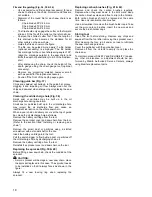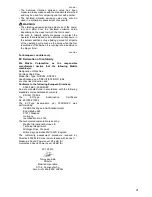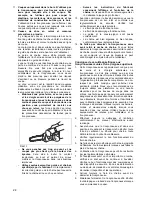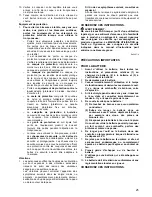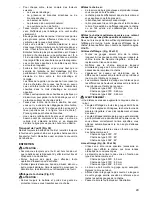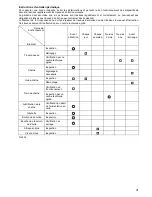
16
CAUTION:
• Do not tighten the saw chain too much. Excessively
high tension of saw chain may cause breakage of saw
chain, wear of the guide bar and breakage of the
adjusting dial.
• A chain which is too loose can jump off the bar, and
therefore presents an accident risk.
• Carry out the procedure of installing or removing saw
chain in a clean place free from sawdust and the like.
Spike bumper (optional accessory) (Fig. 15)
To install spike bumper, perform the following steps:
1.
Remove the sprocket cover, saw chain and guide
bar as described in this instruction manual.
2.
Fit the holes of spike bumper along with the holes on
the chainsaw.
3.
Tighten them firmly with screws.
OPERATION
CAUTION:
• Do not cover vents, or it may cause overheating and
damage to the tool.
Lubrication (Fig. 16 & 17)
Saw chain is automatically lubricated when the tool is in
operation.
Check the amount of remaining oil in the oil tank through
the oil inspection window.
To refill the tank, remove the cap from the oil tank
opening.
After refilling the tank, always screw the provided oil tank
cap on the chain saw.
CAUTION:
• When filling the chain saw with chain oil for the first
time, or refilling the tank after it has been completely
emptied, add oil up to the bottom edge of the filler neck.
The oil delivery may otherwise be impaired.
• As a saw chain oil, use oil exclusively for Makita chain
saws or oil available in market.
• Never use oil including dust and particles or volatile oil.
• When pruning trees, use botanical oil. Mineral oil may
harm trees.
• Never force the chain saw when pruning trees.
• Before cutting out, make sure that the provided oil tank
cap is screwed in place.
Hold the chain saw away from the tree. Start it and wait
until lubrication on saw chain is adequate.
Bring the spike bumper into contact with the branch to be
cut before switching on. Otherwise it may cause the
guide bar to wobble, resulting in injury to operator.
Saw the wood to be cut by just moving it down.
WORKING WITH THE CHAIN SAW
CAUTION:
• The first time user should, as a minimum practice, do
cutting logs on a saw-horse or cradle.
• When sawing precut timber use a safe support (saw
horse or cradle). Do not steady the workpiece with your
foot, and do not allow anyone else to hold or steady it.
• Secure round pieces against rotation.
Pruning trees (Fig. 18, 19, 20 & 21)
CAUTION:
• Keep all parts of the body away from the saw chain
when the motor is operating.
• Hold the chain saw firmly with both hands when the
motor is running.
• Do not overreach. Keep proper footing and balance at
all times.
Bring the spike bumper into contact with the branch to be
cut before switching on. Cutting without bringing the
spike bumper into contact with the branch may cause the
guide bar to wobble, resulting in injury to operator.
When cutting thick branches, first make a shallow
undercut and then make the finish cut from the top.
If you try to cut off thick branches from the bottom, the
branch may close in and pinch the saw chain in the cut. If
you try to cut off thick branches from the top without a
shallow undercut, the branch may splinter.
If you cannot cut the timber right through with a single
stroke:
Apply light pressure to the handle and continue sawing
and draw the chain saw back a little; then apply the spike
a little lower and finish the cut by raising the handle.
Bucking (Fig. 22, 23 & 24)
For bucking cuts, rest the spike bumper shown in the
figure on the wood to be cut.
With the saw chain running, saw into the wood, using the
top handle to raise the saw and the front one to guide it.
Use the spike bumper as a pivot.
Continue the cut by applying slight pressure to the front
handle, easing the saw back slightly. Move the spike
bumper further down the timber and raise the front
handle again.
When making several cuts, switch the chain saw off
between cuts.
CAUTION:
• If the upper edge of the bar is used for cutting, the
chain saw may be deflected in your direction if the
chain becomes trapped. For this reason, cut with the
lower edge, so that the saw will be deflected away from
your body.
Cut wood under tension on the pressure side (A) first.
Then make the final cut on the tension side (B). This
prevents the bar from becoming trapped.
Limbing
CAUTION:
• Limbing may only be performed by trained persons. A
hazard is presented by the risk of kick-back.
When limbing, support the chain saw on the trunk if
possible. Do not cut with the tip of the bar, as this
presents a risk of kickback.
Pay particular attention to branches under tension. Do
not cut unsupported branches from below.
Do not stand on the felled trunk when limbing.
Burrowing and parallel-to-grain cuts (Fig. 25)
CAUTION:
• Burrowing and parallel-to-grain cuts may only be
carried out by persons with special training. The
possibility of kickback presents a risk of injury.
Perform parallel-to-grain cuts at as shallow an angle as
possible. Carry out the cut as carefully as possible, as
the spike bumper cannot be used.

















